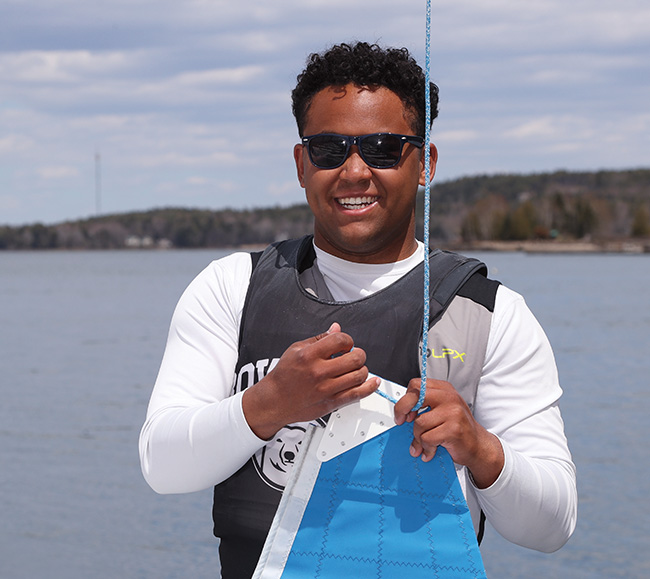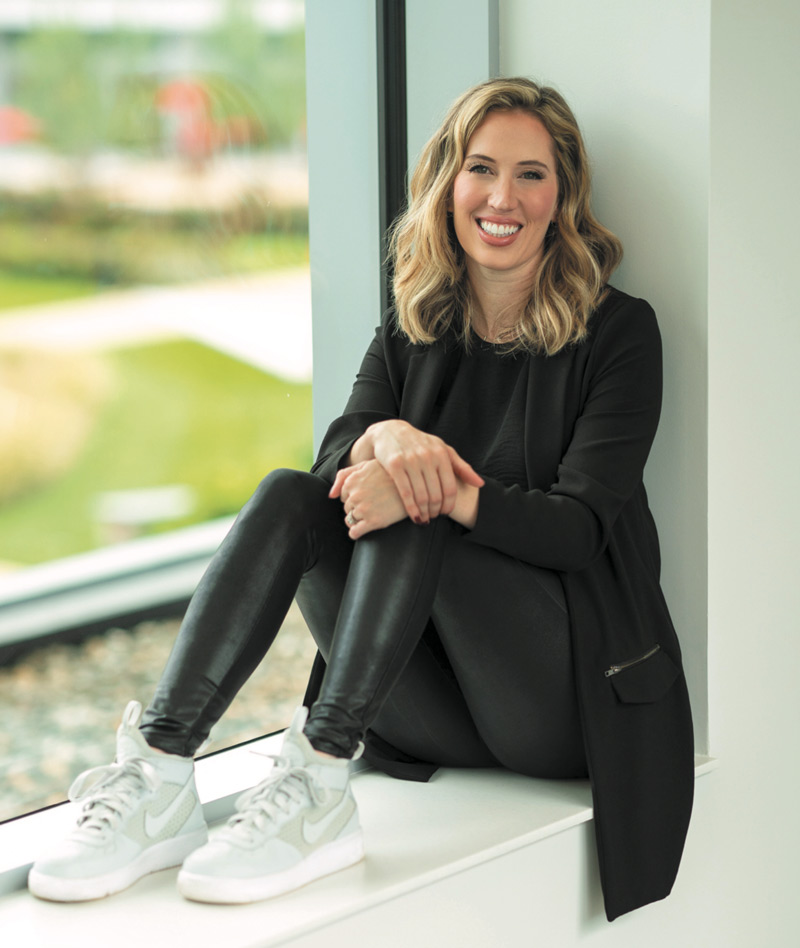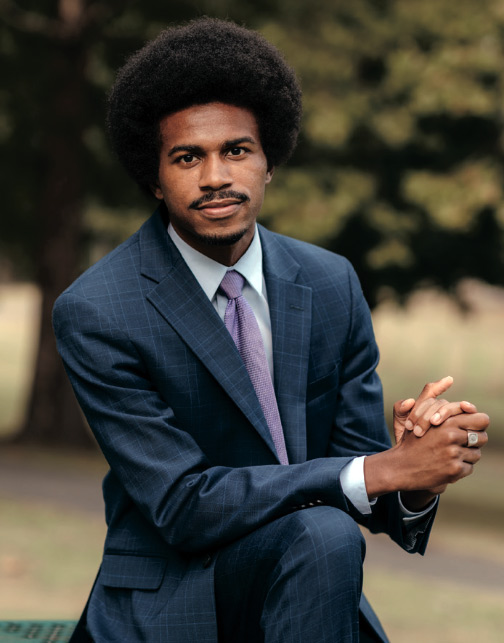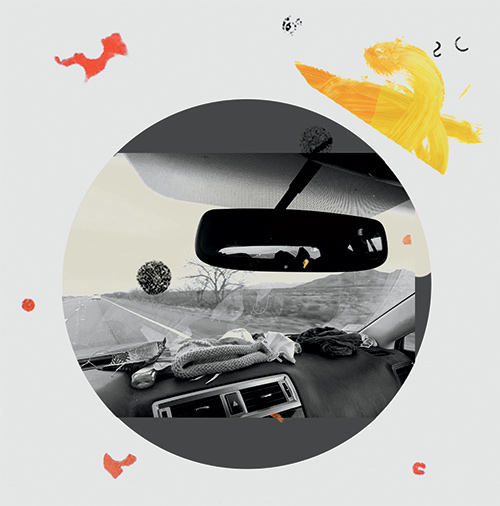Claudia Villar-Leeman '15 on Reaching
By Claudia Villar-Leeman '15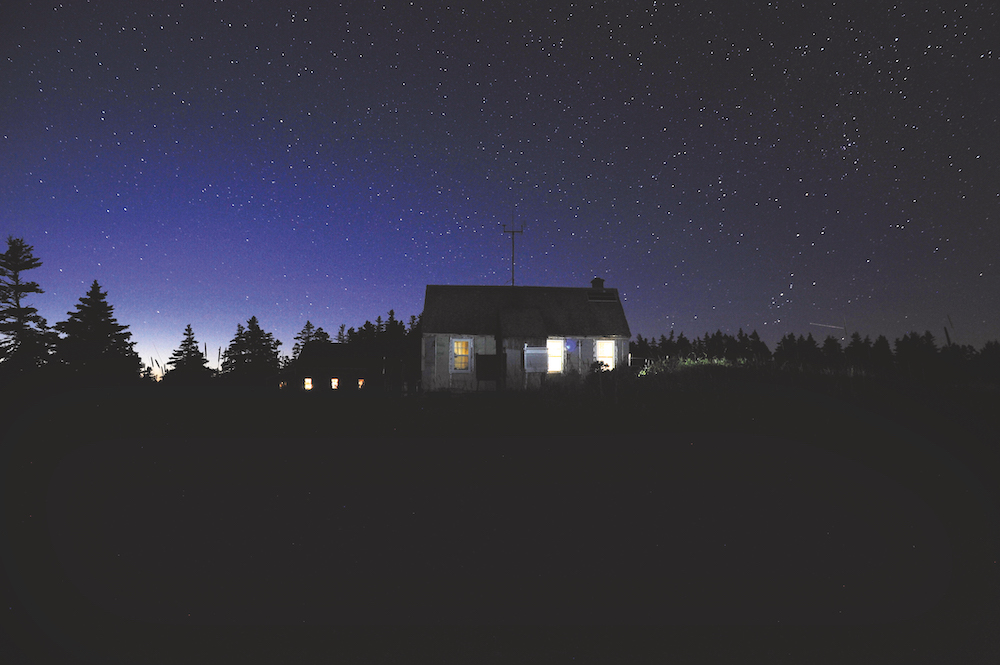
HER DIRTY BLONDE HAIR pulled back under her St. Louis Cardinals cap, Elizabeth kneeled in the damp underbrush. The kneepads of her pants made indentations in the dirt. She leaned forward, rain boots tucked beneath her, lips tight with concentration. Streaks of brown marked her cheeks. Her arm was invisible, swallowed by the mossy earth as she pressed her shoulder against the entrance to a tiny tunnel. I could imagine her fingers stretching, reaching.
Suddenly, a small “Oh!” escaped her—her furrowed brow instantly relaxing as a smile spread across her face. She scooted back, her biceps and then forearm reappearing inch by inch, striped brown and pink. At last, her hand emerged.
Gently pressed between her thumb and index finger was the jet-black bill of a storm-petrel chick—a snowball of pudginess concealed by fine gray down. Elizabeth cupped the small life in her hands, bringing him so close to our faces we could smell the forest and the ocean. The chick’s black eyes were barely visible beneath the wispy down, but he and Elizabeth made eye contact. The chick observed her calmly.
Just days old, this particular storm-petrel had not met a human before, but his gaze seemed expectant. Perhaps memories of human interaction had been passed down by his parents. People had been handling the storm-petrels of the Kent Island colony for decades—since Chuck Huntington established the long-term monitoring study of these remarkable pelagic birds in 1955. Indeed, the Leach’s storm-petrel study is one of the longest-running studies of any wild population of animals in the world.
That morning, Elizabeth and I woke early, donned our knee-high boots and crinkly invincible pants, and trudged through the marsh to a mossy patch of seaside forest Huntington dubbed “the Shire.” We visited hundreds of petrel burrows, as we did every morning, monitoring who had come home after some time away, who had laid an egg, who had gained some weight, who was in a burrow they didn’t usually sleep in. It was very personal business. We made a point to be as polite as possible, apologizing to each bird for our intrusions.
Granted, our attentiveness to the emotional well-being of the birds did not stand in the way of our efficiency. We drew out maps of the 400 or so burrows and planned a path that would allow us to visit all of them in the shortest amount of time. By week six, we had it down to a science. On good days, we’d be done with our monitoring duties by lunchtime. That left us the afternoons for long walks along the shoreline.
We peered into tidepools to watch battles between dog whelks and barnacles. We filled our pockets with noteworthy rocks and marveled together at the pace of geological time. We napped on sun-warmed boulders, triumphing in our harmony with the surrounding colony of sleeping gulls. We paid tribute to the dried carcasses of harbor seal pups and ruminated about the finality of death. We stared at a twitching speckled egg for an hour so we could welcome the miracle of life.
In the evenings, after dinner in the communal mess hall, we would make our way home to the lower lab, our silhouettes enveloped by the purple summer dusk. The small wooden hut was so close to the tidal marsh at the edge of the island that during spring tides the water came right up to the door. The lab’s first floor was filled with scientific knick-knacks—bleached skulls, salty microscopes, an assortment of rusted tools. In the loft above, our sleeping bags were laid out on narrow wooden platforms. The attic window between our beds looked out over the marsh. Each evening we fell asleep to an eerie chorus of petrels. We were sleeping on a speck of land not two miles long, surrounded by the Bay of Fundy, renowned for the largest tides in the world. We felt minuscule and infinite.
"Hope is grounded in our being, in our character and calling, not in some expected outcome. There may not be a reason to be optimistic, but we will be anyway." — Climate Activist Per Espen Stoknes
NO MATTER HOW FAR AWAY we felt from civilization, the human struggle had a way of finding us. We saw it in the plastic washed up on shore; in the satellites Elizabeth traced with a finger as we lay on the dock; in the decades of storm-petrel data collected by students like us. Hatching success was deteriorating. Populations were dwindling. Biodiversity was in decline. And the petrels of Kent Island were not alone.
We knew climate change was shifting the ground beneath the feet, fins, and roots of millions of species. We knew that humanity had never faced a more significant existential crisis. We knew that historically marginalized people would be hit first and hardest.
That fall, Elizabeth and I returned to Brunswick and were pulled back into the life of undergraduate studies. We fell into our separate social spheres. We found our way back toeach other in an ornithology class, memorizing bird calls and taxonomy on long walks. We visited the Yale School of Forestry and dreamed of graduate studies and tackling climate change and fighting injustice and traveling the world.
Our paths separated, reconnected, and separated again. One evening, a few years after we graduated, my phone buzzed. The speech bubble contained words I couldn’t understand.
I heard Elizabeth Brown died.
I blinked.
I heard Elizabeth Brown died.
I buckled.
Died. What a strange word. Short. Unexpected. Like a game of sharks and minnows, where even the speediest fish can have the bad luck of not making it. A word filled with question marks and cliffhangers and what ifs. An irreversible, inevitable word.
She died in her sleep. The autopsy was inconclusive. At her funeral I learned she spent her last day in Shenandoah with her parents, pointing out pileated woodpeckers as they hiked together. I managed a smile through my tears.
THESE DAYS the news is filled with heaviness. It can be hard to pull oneself out of the widening cavern of despair, sore from the jagged unfairness of it all. And yet. From my fire escape, I see a redbellied woodpecker hop along a branch of the elm tree. The blue jays continue their amicable bickering. The squirrels bury their acorns. I watch men install solar panels on the building across from my own. I see a protester on a bike with a colorful face mask, her fist raised. Small triumphs in the face of vast tragedies. I think of the fluffy petrel chick in Elizabeth’s hands.
In the words of climate activist Per Espen Stoknes, “Hope is grounded in our being, in our character and calling, not in some expected outcome. There may not be a reason to be optimistic, but we will be anyway.” The shining meaning of life reveals itself as love. We are minuscule. We are infinite. We continue to reach.
 This story first appeared in the Winter 2021 issue of Bowdoin Magazine. Manage your subscription and see other stories from the magazine on the Bowdoin Magazine website.
This story first appeared in the Winter 2021 issue of Bowdoin Magazine. Manage your subscription and see other stories from the magazine on the Bowdoin Magazine website.
